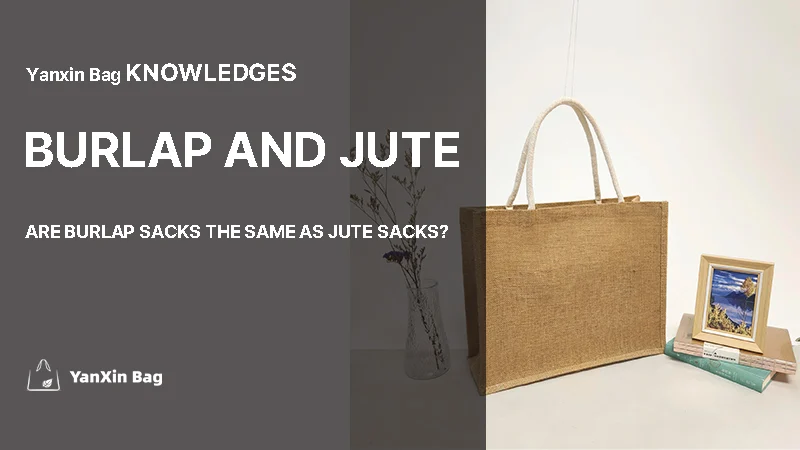
Many people assume that jute and burlap are two entirely different materials. In fact, they come from the same natural fiber—jute—but differ slightly in structure and usage. The terminology used by different countries and suppliers often adds to the confusion. This article will clarify their relationship and differences in terms of raw material, fabric construction, and bag applications, and provide practical guidance for choosing the right option.
As a renewable and biodegradable material, jute is often referred to as the “golden fiber.” It is the second most produced natural fiber globally, following cotton. Raw jute is commonly processed into jute thread, jute fabric, ropes, and bags, and it is traded in its original form before being spun or woven.
There are two common types of jute: Tossa jute, which has a smoother texture, and White jute, which tends to be stiffer. These differences in variety, fiber thickness, and finishing methods directly affect the appearance and texture of the final jute bag.
Understanding jute as a raw material helps clarify its relationship to burlap: jute refers to the fiber itself, while burlap is a type of coarse fabric woven from jute fibers.
Burlap is a coarse woven fabric made from jute fibers, and sometimes blended with hemp. It is typically produced using thick yarns and a loose weave, resulting in a natural tan color with a rough texture that retains the raw look and smell of the fiber.
Technically, burlap is not a raw material but a fabric form—it’s one type of jute fabric. The relationship between jute and burlap is similar to that between cotton and cotton cloth: the former is the raw fiber, and the latter is the processed textile.
Different regions use different terms for this material: in North America, it’s commonly called “burlap,” while in Europe and Australia, the term “hessian” is more widely used. Despite the naming differences, they refer to the same type of fabric.
Understanding this distinction helps clarify a common misconception: burlap is not an alternative to jute, but rather a specific form of fabric made from jute fibers. It’s widely used for agricultural sacks, construction barriers, sandbags, and rustic-style home or commercial packaging.
Jute is widely used for making sacks, bags, and textiles. True
Jute is commonly used to make sacks, bags, carpets, and textiles due to its strength and durability.
Burlap is a synthetic fabric used to mimic natural jute. False
Burlap is made from natural plant-based fibers like jute or hemp, not synthetic materials.
Laminated jute is jute fabric backed with a thin layer of PE (polyethylene) film. This added layer gives the fabric extra stiffness and structure, making the bag more rigid and shapely. It’s commonly used for making structured and visually appealing bags, such as tote bags, gift bags, and branded promotional bags.
Compared to unlaminated jute, laminated jute holds its shape better and offers some resistance to moisture. The smoother surface is also more suitable for printing techniques like screen printing and heat transfer, especially when clear and detailed logos are needed. However, if you’re aiming for a softer, more natural look or a lightweight design, unlaminated jute may be a better fit—for example, in drawstring or foldable bags.
Understanding the structural differences in laminated jute will help you choose the right jute or burlap material based on your specific use case. In the next section, we’ll compare the three most common bag types side by side.
Different types of jute bags vary in structure, printability, and usage. The comparison table below highlights the common features of burlap, unlaminated jute, and laminated jute bags to help you quickly identify which material best suits your needs.
| Feature | Burlap Bag | Jute Bag (Unlaminated) | Jute Bag (Laminated) |
|---|---|---|---|
| Raw Material | Jute or sometimes hemp | 100% natural jute | 100% natural jute |
| Texture | Coarse, loosely woven | Softer, more flexible | Stiff, smooth backing |
| Printability | Limited due to rough texture | Acceptable for basic prints | Better surface for logos and multi-color prints |
| Structure | Loose, floppy, breathable | Soft, foldable | Firm, holds shape well |
| Common Use | Agriculture, sandbags, rustic wrap | Drawstring pouches, soft bags | Gift bags, shopping totes, promotional bags |
| Water Resistance | No | No | Yes (with inner PE lamination) |

Jute is a biodegradable material. True
Jute is a natural fiber that is biodegradable, making it an environmentally friendly option.
Jute and burlap refer to completely different raw materials. False
Burlap is not a separate material but a type of fabric woven from jute fibers.
Burlap bags retain the original coarse texture and breathability of jute fiber. They are best suited for practical uses where visual appearance is less important:
Recommended for: Agricultural packaging, construction use, budget-friendly utility bags
Unlaminated jute bags are soft, foldable, and preserve the natural texture of the fiber. They are ideal for applications that emphasize lightness, eco-consciousness, or a natural aesthetic:
Recommended for: Lightweight storage, drawstring pouches, nature-inspired designs
Laminated jute bags have a layer of PE film on the back, providing better shape retention, moisture resistance, and improved printability. They are a great choice when both structure and visual presentation matter:
Recommended for: Gift packaging, brand promotions, retail shopping bags
While burlap and jute originate from the same natural fiber, different processing methods create bags with very different characteristics. Instead of focusing on naming, it’s more helpful to understand their structure and intended use. Whether you’re looking for a rugged utility sack or a polished promotional tote, the right choice of material can make all the difference.
At Yanxin Bag, we specialize in manufacturing a wide range of burlap and jute bags, offering both laminated and unlaminated options to match your project’s specific needs for structure, visual appeal, and sustainability. We can customize drawstring pouches, gift bags, shopping totes, and more for events, branding, or retail packaging.
All styles can be printed using screen printing, heat transfer, or UV printing techniques to fit your design and brand requirements. Contact us to get a tailored jute bag solution for your business.

Jute has a natural coarse texture, making it suitable for packaging. True
Jute’s coarse texture makes it ideal for packaging materials, especially for heavy-duty bags and sacks.
Every jute bag includes a laminated PE backing. False
Many jute bags are made without lamination to retain a natural look and feel, especially for eco-conscious or foldable bag designs.
Answer: Jute bags are eco-friendly, durable, reusable, and biodegradable. They reduce plastic waste and are cost-effective, making them a great choice for sustainable living.
Answer: Yes, jute bags are strong and durable enough to carry heavy loads. However, for extremely heavy items, alternative materials like canvas or synthetic bags may be more suitable.
Answer: With proper care, jute bags can last up to 4 years or more. They are highly durable but should be kept dry to prevent mold and mildew.
Answer: Yes, jute bags can shrink if washed in a machine. It is recommended to hand wash or spot clean them to maintain their size and shape.
Answer: Jute bags are not naturally water-resistant. They absorb moisture, so it’s essential to keep them dry to avoid mold and mildew growth.
Answer: Burlap is a coarse woven fabric made from jute fibers. It is not a raw material itself, but a specific type of jute fabric. The relationship is similar to that of cotton and cotton cloth—burlap is a processed product made from natural jute fiber.
Answer: Laminated jute bags have a layer of PE film on the back, giving them better structure, moisture resistance, and printability. Unlaminated jute bags retain a softer, more natural texture, making them ideal for drawstring pouches or lightweight reusable bags.
Answer: Machine washing is not recommended for burlap bags. Their loose weave can deform or fray easily in water. For light dirt, spot cleaning with a damp cloth is the preferred method.
Answer: Yes. Burlap bags are often used in wedding decorations, festive packaging, or handmade gift displays thanks to their natural, rustic look that adds an eco-friendly and vintage charm.
Answer: Jute bags can be repurposed for various uses, such as home decor, pet beds, gardening, or storage. Their durability and recyclability make them perfect for creative upcycling.

Order or no-order we are Always here to help you!
We will contact you within 1 working day, please pay attention to the email with the suffix “@yanxinbag.com”.
Order or no-order we are Always here to help you!
We will contact you within 1 working day, please pay attention to the email with the suffix “@yanxinbag.com”.